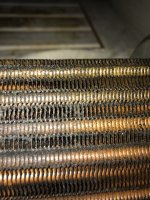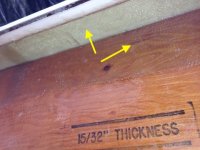With a jet, one is limited to the amount of water we can suck. Yes, that is the limiting factor of a water jet. The way it works, there's a point on the intake side of the pump that is a low pressure area. At some torque applied, the pressure of the water will get so low it will turn to water vapor(state change) and then there's no way to push any water through the impeller and compress it.
There are a very few limited cases where a jet boat has gone over 120MPH. The intake is as high flow, and low restriction as possible. Everything has to be smooth as glass, and no sharp corners or rough spots. Most stock jet boats will run out of steam(no pun intended) right about 90MPH, with a good clean intake and no grate to start the disruption.
At this point, I'm looking at the money part of the rebuild. I got the boat for $1000 incl the trailer. I've spent $200 on the trailer getting it ready. The engine is going to be about $3300, and the FG work will be at least $5000. By the time I get to the interior work, I'm gonna be well upside down on the value of the boat. Oh well. At least it will be almost like new when done.
I checked out the hull today. All the rot is gone, and he's going to start cutting and fitting today.
There are a very few limited cases where a jet boat has gone over 120MPH. The intake is as high flow, and low restriction as possible. Everything has to be smooth as glass, and no sharp corners or rough spots. Most stock jet boats will run out of steam(no pun intended) right about 90MPH, with a good clean intake and no grate to start the disruption.
At this point, I'm looking at the money part of the rebuild. I got the boat for $1000 incl the trailer. I've spent $200 on the trailer getting it ready. The engine is going to be about $3300, and the FG work will be at least $5000. By the time I get to the interior work, I'm gonna be well upside down on the value of the boat. Oh well. At least it will be almost like new when done.
I checked out the hull today. All the rot is gone, and he's going to start cutting and fitting today.




















![20220906_122016[1].jpg](/data/attachments/369/369839-30c45f5325038af004fa9e7dc5a25402.jpg)
![20220906_122010[1].jpg](/data/attachments/369/369840-31ce722100f0c1f97ccaa07dba61dfc2.jpg)
![20220906_121952[1].jpg](/data/attachments/369/369841-2dfcec5512df3f0240c435b6c38667d7.jpg)
![20220906_121943[1].jpg](/data/attachments/369/369842-48ef2cb0e5f84905fe35027677cfbd16.jpg)


